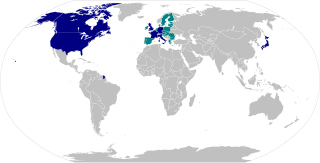
G is the seventh letter in the ISO basic Latin alphabet.

The G-spot, also called the Gräfenberg spot, is characterized as an erogenous area of the vagina that, when stimulated, may lead to strong sexual arousal, powerful orgasms and potential female ejaculation. It is typically reported to be located 5–8 cm (2–3 in) up the front (anterior) vaginal wall between the vaginal opening and the urethra and is a sensitive area that may be part of the female prostate.

Christopher George Latore Wallace, known professionally as The Notorious B.I.G., Biggie Smalls, or Biggie, was an American rapper. He is widely considered to be one of the greatest rappers of all time. The Notorious B.I.G. was noted for his "loose, easy flow"; dark, semi-autobiographical lyrics; and storytelling abilities, which focused on crime and hardship.

The Mikoyan MiG-29 is a twin-engine jet fighter aircraft designed in the Soviet Union. Developed by the Mikoyan design bureau as an air superiority fighter during the 1970s, the MiG-29, along with the larger Sukhoi Su-27, was developed to counter new U.S. fighters such as the McDonnell Douglas F-15 Eagle and the General Dynamics F-16 Fighting Falcon. The MiG-29 entered service with the Soviet Air Forces in 1982.

Kenneth Bruce Gorelick, better known by his stage name Kenny G, is an American jazz saxophonist. His 1986 album, Duotones, brought him commercial success. Kenny G is one of the best-selling artists of all time, with global sales totaling more than 75 million records.

The Group of Seven (G7) is an international intergovernmental economic organization consisting of the seven largest IMF-described advanced economies in the world: Canada, France, Germany, Italy, Japan, the United Kingdom and the United States.

The G20 is an international forum for the governments and central bank governors from 19 countries and the European Union (EU). Founded in 1999 with the aim to discuss policy pertaining to the promotion of international financial stability, the G20 has expanded its agenda since 2008 and heads of government or heads of state, as well as finance ministers and foreign ministers, have periodically conferred at summits ever since. It seeks to address issues that go beyond the responsibilities of any one organization.
Coreura is a genus of moths in the subfamily Arctiinae. The genus was erected by Francis Walker in 1865.

The Procter & Gamble Company (P&G) is an American multinational consumer goods corporation headquartered in Cincinnati, Ohio, founded in 1837 by William Procter and James Gamble. It specializes in a wide range of personal health/consumer health, and personal care and hygiene products; these products are organized into several segments including Beauty; Grooming; Health Care; Fabric & Home Care; and Baby, Feminine, & Family Care. Before the sale of Pringles to Kellogg's, its product portfolio also included foods, snacks, and beverages. P&G is incorporated in Ohio.

5G is the fifth generation of cellular network technology. The industry association 3GPP defines any system using "5G NR" software as, "5G", a definition that came into general use by late 2018. Others may reserve the term for systems that meet the requirements of the ITU IMT-2020. 3GPP will submit their 5G NR to the ITU. It follows 2G, 3G, 4G, and their respective associated technologies. In addition to traditional mobile operator services, 5G NR also addresses specific requirements for private mobile networks ranging from industrial IoT to critical communications.

Rebbeca Marie Gomez, known as Becky G, is an American singer, songwriter and actress. Gomez first gained recognition in 2011 when she began posting videos of herself covering popular songs online. One of her videos caught the attention of producer Dr. Luke, who subsequently offered her a joint record deal with Kemosabe Records and RCA Records. While working on her debut effort, Gomez collaborated with artists will.i.am, Cody Simpson and Cher Lloyd. Her official debut single, "Becky from the Block" (2013), received a positive reception upon its release. She released her debut extended play, Play It Again (2013), later that same year. Her second single, "Can't Get Enough" (2014), featured guest vocals from Pitbull and went on to top the Latin Rhythm Airplay chart in the United States.
Coreura albicosta is a moth of the subfamily Arctiinae. It was described by Max Wilhelm Karl Draudt in 1915. It is found in Mexico.
Coreura cerealia is a moth of the subfamily Arctiinae. It was described by Druce in 1897. It is found in Ecuador.
Coreura eion is a moth of the subfamily Arctiinae. It was described by Herbert Druce in 1896. It is found in Costa Rica and Panama.
Coreura engelkei is a moth of the subfamily Arctiinae. It was described by Rothschild in 1912. It is found in Colombia.
Coreura euchromioides is a moth of the subfamily Arctiinae. It was described by Francis Walker in 1864. It is found in Colombia.
Coreura fida is a moth of the subfamily Arctiinae. It was described by Jacob Hübner in 1827. It is found in Mexico and Brazil.
Coreura interposita is a moth of the subfamily Arctiinae. It was described by George Hampson in 1901. It is found in Venezuela.
Coreura lysimachides is a moth of the subfamily Arctiinae. It was described by Herbert Druce in 1897. It is found in Ecuador and Peru.
Coreura simsoni is a moth of the subfamily Arctiinae. It was described by Druce in 1885. It is found in Colombia, Ecuador and Bolivia.












